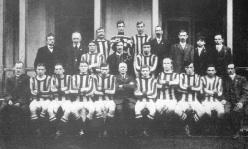First hoops for Belfast Celtic’s minister for defence
Published in 20th-century / Contemporary History, Issue 2 (March/April 2010), News, Volume 18
The Belfast Celtic team that won five matches and drew one on a tour to Prague in 1912. Oscar Traynor is in the back row (fourth from left) in the hooped jersey. (Belfast Celtic Society)
Bornin north Dublin in 1886, Oscar Traynor participated in the 1916 Rising,led the attack on the Customs House in 1921, was jailed for his part onthe anti-Treaty side in the Civil War, was elected a Fianna Fáil TD andserved as minister for defence in various Fianna Fáil administrations .. . and he played in goal for Belfast Celtic.
His stint with theteam coincided with the Home Rule crisis, as Carson’s volunteersmustered on hillsides and on the horizon loomed the dreadful spectre ofEuropean slaughter. In the season (1911–12) that the Titanic sloshedoff the slipway at Queen’s Island, Belfast Celtic scooped the inauguralGold Cup and Charity Cup. A record-breaker, the 3–0 Charity Cup winagainst Cliftonville raised an incredible £166 for various good causes.Second-string football was also delivering success, as Celtic’sreserves lifted the Steel and Sons cup, beating Glentoran 3–1.
Flushedwith success, Celtic’s directors, never short of ideas, took the teamto Europe—the first time a club from these islands toured foreignshores. And it was a success, as Belfast’s ‘Stripes’ won five games inthe central European city of Prague, drawing the sixth. It stillrankles that in Celtic’s drawn game the referee never left the cornerflag area, denying Celtic six of the best!
Between the sticks wasthe dependable Oscar Traynor, with fellow Dubliner Louis Crowe joininghim in the side at centre forward. The team picture snapped in thecurrent capitol of the Czech Republic (above) shows Traynor in themiddle of the back row in a different jersey to his team mates—normalfor any goalkeeper, except this jersey was significant: it was the‘hoops’, more associated with Celtic’s Glasgow cousins, making Traynorthe first Belfast Celt to wear the famous jersey now known around theworld.
Sadly, just four years later he found himself not between thesticks but behind the wire. As barricades rose in Dublin and Pearseread the Proclamation at the GPO, a column under the command of Traynoroccupied the strategically important Metropole Hotel on SackvilleStreet. Before Easter 1916 he was tackling strikers from Linfield andDistillery—now Traynor was tackling the British Empire! He laterchillingly recalled watching shells from the gunboat Helga raining downon Dublin, destroying the central thoroughfare:
‘Some time onThursday a barricade which stretched from the Royal Hibernian Academyto a cycle shop—I think it was Keating’s—on the opposite side of thestreet, took fire as a result of a direct shell hit. It was the firingof this barricade that caused the fire that wiped out the east side ofO’Connell Street. I saw that happen myself. Then Hoyt’s caught fire andthe whole block up to Earl Street became involved and I saw the firespread from there to Clery’s . . . and the Imperial Hotel.’
Traynor tried to warn others of the spreading fire, revealing:
‘Beforethat happened those of us in the Metropole made tremendous efforts towarn the garrison in the Imperial Hotel of the grave danger whichmenaced them. If our messages, which were sent by semaphore, wereunderstood they do not appear to have been acted on, as the eventualevacuation of the Imperial Hotel appears to have been a rather hurriedone.’
He remembered ‘seeing the huge plate-glass windows of Clery’s stores run molten into the channel from the terrific heat’.
Asthe rebels surrendered, Traynor was frog-marched to prison andtransported to the desolate Welsh hamlet of Frongoch—interned in adreary prison camp. Sport was shelved as Traynor was immersed in thenational struggle, and on his release he led the IRA’s Dublin Brigade,working with Michael Collins. As the Treaty negotiations crystallisedin London in late 1921, Traynor found himself at odds with his old allyCollins, joining the Republican forces committed to removing the newdétente with Britain. Collins ordered the shelling of theRepublican-occupied Four Courts, with borrowed British artillery,flexing the muscles of the new Irish Free State. As British shellsagain peppered the city, Traynor and his men again occupied SackvilleStreet, where they’d fought the British just six years before. After aweek of fierce fighting, when Cathal Brugha made his final stand, heled his men south, organising guerilla actions in South Dublin andWicklow before capture and imprisonment for the rest of the war.
Onrelease, he followed de Valera into Fianna Fáil and held cabinetportfolios for justice, posts and telegraphs, and, appropriately for aformer goalkeeper, defence! But football was never far from his heartand, following the defeat of Fianna Fáil in the 1948 general election,Traynor was elected president not of his country but of the FootballAssociation of Ireland, a post he held until his death, aged 77, in1963.
He left other sporting legacies too. In his old constituency,on Oscar Traynor Road, a major arterial route serving Artane, Coolock,Darndale and Donaghmede, sits the Oscar Traynor Centre, a key sportingfacility for Dublin’s northside citizens. In addition, the OscarTraynor Trophy is one of the biggest junior football tournaments onthese islands. Declan Smith from the Oscar Traynor Centre explained:
‘Thiscompetition is held in his honour every year. Teams compete fromDonegal to Cork in areas covered by the Football Association of Irelandand, with representative sides drawn from every amateur league, it’s awho’s who of Irish junior football—a really big deal. The amateurfootball league based here won it two years ago and it was very specialto bring the beautiful Waterford Crystal vase back to the Oscar TraynorCentre.’
So from wearing the hoops in Belfast to facilitatingfootballers on the meadows of north Dublin—with prisons, protests andparty politics in between—the case for Belfast Celtic’s minister fordefence is as strong as it was a century ago. HI
Martin Flynnis Communications Officer with the Community Foundation, NorthernIreland, and a member of the Belfast Celtic Society.
















